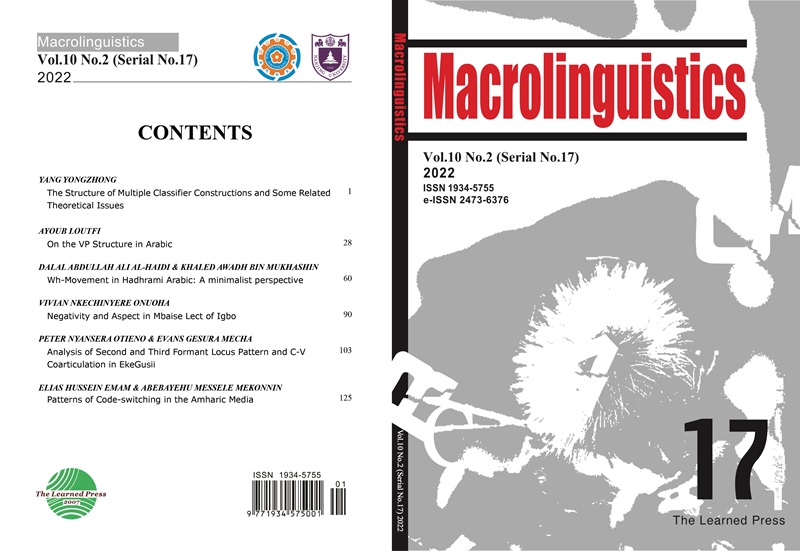Afaan Oromoo中的因果结构:形式和语义视角
引用次数: 0
摘要
(埃塞俄比亚)摘要:本研究的主要目的是描述Afaan Oromoo中致使结构的形式和功能方面。为了实现这一目标,书面文本、母语者的信息和内省主要被用作数据来源。研究结果表明,致使词的三个结构方面——形态、词汇和句法——在语言中都有使用。形态因果词是高效的,在几个组合中带有-s和-i的词缀以及-eess都用于这种目的。因果词素被检测为派生不同语义类别的基本动词词干的因果关系,并在词类变化中涉及因果关系。也有简单的和复杂的原因,其中有几个原因后缀、原因和微观事件从形态和句法上表示。在语义上,直接、间接和辅助/合作的因果关系被识别。伪因果关系也被揭示为语言的特殊未来。甚至,也有一些结构带有明确的致使词缀,称为无主词致使词,但它们并没有显示出参与者之间的任何因果关系本文章由计算机程序翻译,如有差异,请以英文原文为准。
Causative Constructions in Afaan Oromoo: Formal and semantic perspectives
, Ethiopia) Abstract: The main objective of this study is to give descriptions of formal and functional aspects of causative constructions in Afaan Oromoo. To achieve the objective, written texts, native speaker informants and introspections are predominantly used as sources of data. The findings reveal that the three structural aspects of causatives- morphological, lexical and syntactic- are used in the language. Morphological causatives are highly productive, and affixes with -s and -i in several combinations as well as -eess are employed for such purposes. Causative Morphemes are detected to derive causatives of basic verb stems of different semantic categories and to involve causations in word-class changing. There are also simple and complex causations in which there are several causatives suffixes, causers and micro-events indicated morphologically and syntactically. Semantically, direct, indirect, and assistive/cooperative causatives are identified. Pseudo-causatives are uncovered as peculiar futures of the language too. There are, even, structures with explicit causative affixes which are called subjectless causatives, but they do not show any causal relations between the participants in
求助全文
通过发布文献求助,成功后即可免费获取论文全文。
去求助
来源期刊
自引率
0.00%
发文量
83
审稿时长
20 weeks
期刊介绍:
Macrolinguistics (ISSN 1934-5755, e-ISSN 2473-6376) is an international academic journal which is specialized in research papers of non-Indo-European linguistics. It is published biannually by The Learned Press and funded by the Double First-Class Initiative of Nanjing University. It aims at contributing to the complementarity and interaction of linguistic research worldwide.

 求助内容:
求助内容: 应助结果提醒方式:
应助结果提醒方式:


